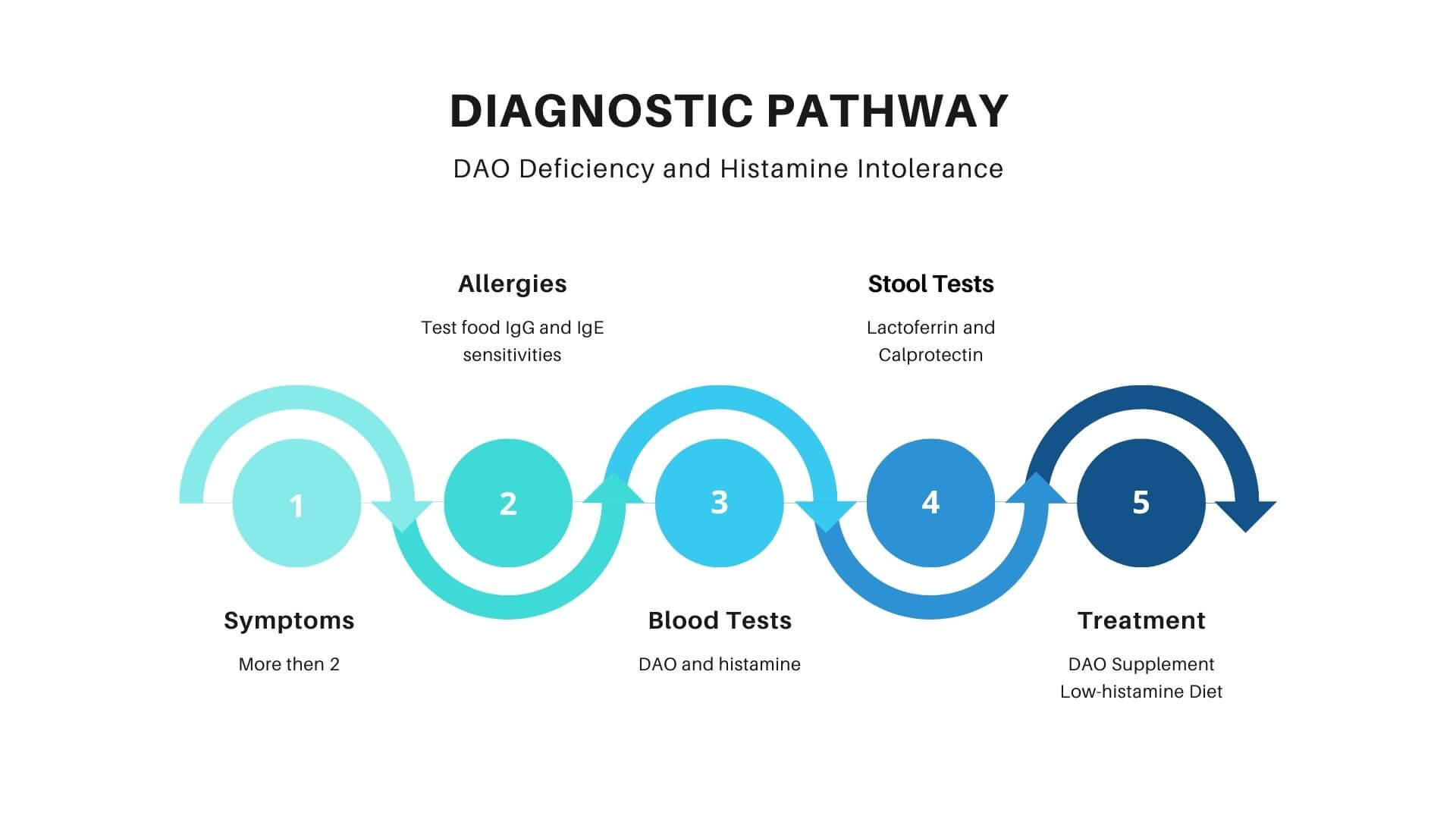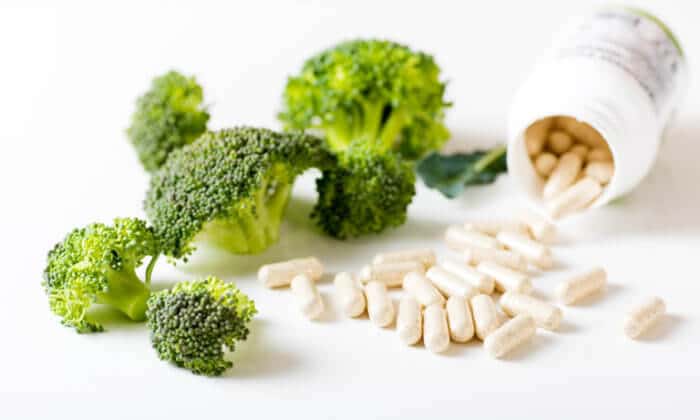Histamine Intolerance and DAO Deficiency: The Missing Elements as the Cause of CFS and IBS
| | Reading Time: 7 minutes

In this article, I start with a case to show how frustrating to patients and their doctors this condition becomes. Then I’ll outline what you need to know about DAO deficiency and it’s consequence, histamine intolerance. And you’ll learn how savvy doctors diagnose these conditions and what you can do about taming them.
No doctor seemed to understand this 31-year-old, previously healthy athletic man’s complaints. It’s not that he hadn’t sought out the best doctors because he had. Many of them. It’s not that he didn’t get high-quality care or the proper tests because he had. Admittedly, he had improved, but he still didn’t feel well.
Symptoms
It had been a hellish few years. It started with what seemed like a bad cold that lingered for months with symptoms including swollen lymph nodes, nausea and vomiting, headaches, sensitivity to common foods, bloating, debilitating fatigue, and difficulty concentrating.
Though he improved over time, some symptoms worsened. As the months passed, his multiple complaints became chronic. All these symptoms could be associated with a viral infection, and at first, that’s what his doctors diagnosed. And one of his doctors agreed that his illness could be from a chronic virus, like Epstein-Barr. But, others couldn’t find anything wrong with him and were reluctant to pursue his case further.
Treatment
Going on his own, he tried different diets, supplements, and even meditation, plus treatments recommended by alternative healthcare practitioners. All were of little help. Scouring websites, he read blogs blaming Lyme Disease and Epstein Barr Virus, parasites, and hormone deficiencies. He had more tests but found nothing. Perhaps it was a chronic virus. Eventually, he found me because my clinical focus is viral immunity.
Diagnose
I spent hours going over his extensive medical records and pages of lab test results. He had tests for allergies, but his doctors couldn’t find any. His immunological test results were normal. Nor was he immunodeficient and didn’t have an autoimmune condition. He didn’t have Lyme disease. Nor a fungal infection. But on a hunch, one of his doctors tested his diamine oxidase (DAO). It was very low.
Could DAO deficiency be the cause of his diverse symptoms?
A year later, he had another DAO blood test, and it was even lower. To make sure, his doctor retested. The third result confirmed that his level of this critical enzyme was deficient. And his constellation of symptoms was consistent with low DAO. Because his doctor found no infectious or immunological cause, he was diagnosed with DAO deficiency and started on enzyme replacement.
What Is DAO Deficiency?
DAO is the enzyme diamine oxidase produced mainly in the kidneys and the thymus gland in the gut lining. In comparison, the digestive enzymes lipase and amylase, needed to breakdown fats and carbohydrates, are made in the pancreas. DAO is not a digestive enzyme. It’s the enzyme responsible for the metabolism of histamine ingested from food. Not enough DAO leads to the buildup of histamine. And too much histamine causes a variety of adverse effects in many body systems.
Symptoms of DAO Deficiency
- Headaches, including migraines and vascular headaches
- Persistent fatigue
- Muscle soreness and fibromyalgia
- ADHD
- IBS and other GI disorders
The theory is that DAO deficiency causes abnormal metabolism of dietary histamine. An imbalance between ingested histamine, the histamine released from our body cells, and the ability to breakdown histamine leads to a buildup of histamine in the blood, triggering various symptoms.
What Is the Significance of Histamine to Health?
We tend to think of histamine as the cause of seasonal allergies, like when oak trees or cedars flower in the spring. But histamine is produced under many other circumstances. Cells release histamine as a response to tissue injury, not just allergic reactions. The symptoms of swelling and itching are the same though caused by different conditions. The standard treatment is to take antihistamines.
But histamine does more than modulate allergies and responds to injuries. It’s also an important chemical messenger that sends signals to your brain. And it triggers the release of stomach acid to help digestion. Histamine is synthesized in basophils and mast cells, a multi-purpose master cell residing in the connective tissue. As part of the body’s inflammatory response, mast cells function as first responders to defend against infections and allergies.
And in the brain, histamine acts as a neurotransmitter. So histamine it not just the cause of hay fever; it plays an essential role in both the immune and nervous systems, a central molecule that regulates neuroimmunity.
The gateway for dietary histamine is through the gut lining. Sufficient DAO protects against the absorption of too much histamine from foods. Gut barrier insufficiency, or “leaky gut,” allows histamine to enter the bloodstream. A healthy intestinal mucosal membrane barrier ensures the containment of histamine and other undesirable substances.
Adequate DAO plays a role in controlling the histamine in foods from invading the blood. Processed, preserved, and fermented foods have high levels of histamine. Beer and red wine have the most histamine. Fresh fruit, nuts, vegetables, and meats are low in histamines.

High Histamine foods:
- Aged cheeses
- Beans
- Beer
- Canned and pre-prepared foods
- Chocolate and cacao
- Citrus fruits
- Peanuts
- Pickled and canned foods
- Products containing yeast
- Red wine
- Rice vinegar
- Sandwich meats
- Sauerkraut
- Shellfish
- Tomatoes
- Walnuts
Dr Williams video: “Quick Takes: DAO Deficiency and Histamine Intolerance”

Histamine Intolerance Causes Multiple Symptoms
Over time, the body cannot adequately process histamine, leading to intolerance followed by symptoms. Histamine intolerance and DAO deficiency go hand-in-hand.
Common histamine reactions are associated with allergies, including runny nose, congestion, sneezing, and difficulty breathing. You may have itchy skin, flushing, hives, and swelling. And too much histamine causes headaches and dizziness. In the gut, too much histamine causes bloating, gas, diarrhea, abdominal pain, constipation, nausea, and vomiting. It also affects the heart and can cause irregular heart rate, rapid heartbeat, and even muscle weakness with decreased tone.
Symptoms of High Histamine:
- Swelling, redness, and itching
- Nasal congestion and sinus swelling
- Chronic headaches
- Migraines
- Nausea and vomiting
- Cramping
- Irregular menses
- Fatigue
- Brain fog
- Food sensitivities
Two other related conditions that cause many of the same symptoms include eosinophilic gastritis and mast cell activation syndrome. But, I’ll leave these conditions for another discussion.
You can now see that nearly all of the symptoms of CFS/IBS are just like DAO deficiency and histamine intolerance. How can you tell if you have DAO deficiency and histamine intolerance?
How Laboratory Tests Can Detect Histamine Intolerance
Though European labs were already testing DAO levels, clinical laboratories in the United States did not test for DAO until recently. Even now, only a few labs offer DAO deficiency tests. Histamine tests are available from standard reference laboratories, including Quest Diagnostics and LabCorp. For DAO blood levels, I use Precision Point Diagnostics.
Tests for DAO Deficiency and Histamine Excess
| Laboratory | Quest Diagnostics | LabCorp | Precision Poin Diagnostics |
|---|---|---|---|
| Diamine Oxidase (DAO) | >42. ng/mL | ||
| Plasma Histamine | <1.8 ng/mL | 0.3-1.0 ng/mL | <1.2 ng/mL |
| Total Immunoglobuline E (IgE) | <114 kU/L | 6-495 IU/mL |
A Pathway to Restore DAO Deficiency and Histamine Balance
If you’ve been diagnosed with CFS/IBS, leaky gut, or food allergies and are not improving, you may have DAO deficiency. Because lack of DAO leads to an overload of histamine, you may also have histamine intolerance. For my patients, if they have two or more symptoms associated with low DAO or high histamine, I begin with food sensitivity testing and also check the DAO and histamine levels in their blood. And inflammation markers in a stool sample like lactoferrin and calprotectin are useful in diagnosing more serious inflammatory gut conditions.

The treatment is straightforward. Take a DAO supplement. Get adequate amounts of vitamin C, B-complex with B6, and copper to support DAO activity. Take bioflavonoids including quercetin and luteolin to modulate histamine.
And try probiotics known to tame histamine intolerance, including Bifido infantis and Lactobacillus longan; Lactobacillus planetarium and Lactobacillus rhamnosis. Avoid those strains that can increase including Lactobacillus bulgaricus and Lactobacillus casei, both found in yogurt.
Take a DAO enzyme supplement derived from porcine kidney extract containing Diamine Oxidase Activity 10,000 HDU per capsule. Start with one capsule 15 minutes before each meal. The maximum dosage is two capsules (20,000 HDU) three times daily before meals.
And reduce histamine levels by following a low-histamine diet for 30 days. You’ll find the low-histamine diet more restrictive than either a gluten-free or lectin avoidance diet. Though your food choices are limited and your diet becomes simple, you can experience significant symptoms relief by avoiding high histamines foods and consuming more foods low in histamine.
Low-Histamine foods:
- Boiled or poached eggs
- Rice and nut milk
- Apples and most fresh fruits, except citrus
- Fresh vegetables, except nightshades like tomatoes and eggplant
- Rice, quinoa, corn
- Herbal tea
The Results Are In
DAO deficiency and histamine intolerance are underestimated and underdiagnosed causes of food intolerance, CFS, and IBS. It’s about time we stopped blaming “stress” and viruses, and food allergies – all overly simplified approaches to complex, multisymptomatic, multisystem disorders of modern lifestyles.
The patient is doing better. He’s not entirely well yet. And I’ll order follow-up tests, including histamine and DAO levels. But I’m confident he’s no longer misdiagnosed and not blaming the wrong causes of his mysterious illness.
To Learn More:
- International Society of DAO Deficiency https://www.deficitdao.org/en/
- DAO Deficiency https://daodeficiency.org/
- Contact Dr. J.E. Williams
Selected References:
Chehade, M., Kamboj, A. P., Atkins, D., & Gehman, L. T. (2021). Diagnostic Delay in Patients with Eosinophilic Gastritis and/or Duodenitis: A Population-Based Study. Journal of Allergy and Clinical Immunology: In Practice. https://doi.org/10.1016/j.jaip.2020.12.054
Comas-Basté, O., Sánchez-Pérez, S., Veciana-Nogués, M. T., Latorre-Moratalla, M., & Vidal-Carou, M. D. C. (2020). Histamine intolerance: The current state of the art. Biomolecules, 10(8), 1–26. https://doi.org/10.3390/biom10081181
ImuPro. (2016). Histamine Intolerance Test. http://www.imupro.com.au/food-intolerance/symptoms/histamine-intolerance-b/
Maintz, L., & Novak, N. (2007). Histamine and histamine intolerance. American Journal of Clinical Nutrition, 85(5), 1185–1196. https://doi.org/10.1093/ajcn/85.5.1185
Schnedl, W. J., Schenk, M., Lackner, S., Enko, D., Mangge, H., & Forster, F. (2019). Diamine oxidase supplementation improves symptoms in patients with histamine intolerance. Food Science and Biotechnology, 28(6), 1779–1784. https://doi.org/10.1007/s10068-019-00627-3


